+ Open data
Open data
- Basic information
Basic information
| Entry | Database: EMDB / ID: EMD-30293 | |||||||||
|---|---|---|---|---|---|---|---|---|---|---|
| Title | Cryo-EM structure of human TLR3 in complex with UNC93B1 | |||||||||
 Map data Map data | ||||||||||
 Sample Sample |
| |||||||||
 Keywords Keywords | Toll-like receptors / UNC93B1 / MFS / IMMUNE SYSTEM | |||||||||
| Function / homology |  Function and homology information Function and homology informationTLR3 deficiency - HSE / response to dsRNA / UNC93B1 deficiency - HSE / type III interferon production / positive regulation of type III interferon production / TICAM1 deficiency - HSE / toll-like receptor 7 signaling pathway / TRAF3 deficiency - HSE / T cell antigen processing and presentation / regulation of dendritic cell cytokine production ...TLR3 deficiency - HSE / response to dsRNA / UNC93B1 deficiency - HSE / type III interferon production / positive regulation of type III interferon production / TICAM1 deficiency - HSE / toll-like receptor 7 signaling pathway / TRAF3 deficiency - HSE / T cell antigen processing and presentation / regulation of dendritic cell cytokine production / Toll Like Receptor 3 (TLR3) Cascade / Toll-like receptor binding / inflammatory response to wounding / TLR3-mediated TICAM1-dependent programmed cell death / activation of NF-kappaB-inducing kinase activity / toll-like receptor 3 signaling pathway / detection of virus / toll-like receptor 9 signaling pathway / necroptotic signaling pathway / RIP-mediated NFkB activation via ZBP1 / early phagosome / positive regulation of cytokine production involved in inflammatory response / endolysosome membrane / Trafficking and processing of endosomal TLR / hyperosmotic response / positive regulation of macrophage cytokine production / toll-like receptor signaling pathway / pattern recognition receptor activity / cellular response to exogenous dsRNA / RSV-host interactions / response to exogenous dsRNA / negative regulation of osteoclast differentiation / ubiquitin-like protein ligase binding / positive regulation of interferon-alpha production / cellular response to interferon-beta / positive regulation of chemokine production / JNK cascade / extrinsic apoptotic signaling pathway / positive regulation of interleukin-12 production / Regulation of TBK1, IKKε-mediated activation of IRF3, IRF7 upon TLR3 ligation / extracellular matrix / TICAM1,TRAF6-dependent induction of TAK1 complex / TICAM1-dependent activation of IRF3/IRF7 / positive regulation of interferon-beta production / TICAM1, RIP1-mediated IKK complex recruitment / positive regulation of interleukin-8 production / positive regulation of JNK cascade / intracellular protein transport / microglial cell activation / cellular response to mechanical stimulus / antigen processing and presentation of exogenous peptide antigen via MHC class II / cellular response to virus / cellular response to type II interferon / positive regulation of interleukin-6 production / male gonad development / cellular response to xenobiotic stimulus / positive regulation of type II interferon production / cell morphogenesis / positive regulation of angiogenesis / positive regulation of inflammatory response / positive regulation of tumor necrosis factor production / transmembrane signaling receptor activity / signaling receptor activity / double-stranded RNA binding / defense response to virus / early endosome / lysosome / positive regulation of canonical NF-kappaB signal transduction / endosome / endosome membrane / defense response to bacterium / positive regulation of apoptotic process / Golgi membrane / lysosomal membrane / innate immune response / positive regulation of gene expression / endoplasmic reticulum membrane / endoplasmic reticulum / signal transduction / positive regulation of transcription by RNA polymerase II / extracellular space / identical protein binding / membrane / plasma membrane / cytoplasm Similarity search - Function | |||||||||
| Biological species |  Homo sapiens (human) Homo sapiens (human) | |||||||||
| Method | single particle reconstruction / cryo EM / Resolution: 3.4 Å | |||||||||
 Authors Authors | Ohto U / Ishida H | |||||||||
 Citation Citation |  Journal: Nat Struct Mol Biol / Year: 2021 Journal: Nat Struct Mol Biol / Year: 2021Title: Cryo-EM structures of Toll-like receptors in complex with UNC93B1. Authors: Hanako Ishida / Jinta Asami / Zhikuan Zhang / Tomohiro Nishizawa / Hideki Shigematsu / Umeharu Ohto / Toshiyuki Shimizu /  Abstract: Nucleic acid-sensing Toll-like receptors (TLRs) play a pivotal role in innate immunity by recognizing foreign DNA and RNA. Compartmentalization of these TLRs in the endosome limits their activation ...Nucleic acid-sensing Toll-like receptors (TLRs) play a pivotal role in innate immunity by recognizing foreign DNA and RNA. Compartmentalization of these TLRs in the endosome limits their activation by self-derived nucleic acids and reduces the possibility of autoimmune reactions. Although chaperone Unc-93 homolog B1, TLR signaling regulator (UNC93B1) is indispensable for the trafficking of TLRs from the endoplasmic reticulum to the endosome, mechanisms of UNC93B1-mediated TLR regulation remain largely unknown. Here, we report two cryo-EM structures of human and mouse TLR3-UNC93B1 complexes and a human TLR7-UNC93B1 complex. UNC93B1 exhibits structural similarity to the major facilitator superfamily transporters. Both TLRs interact with the UNC93B1 amino-terminal six-helix bundle through their transmembrane and luminal juxtamembrane regions, but the complexes of TLR3 and TLR7 with UNC93B1 differ in their oligomerization state. The structural information provided here should aid in designing compounds to combat autoimmune diseases. | |||||||||
| History |
|
- Structure visualization
Structure visualization
| Movie |
 Movie viewer Movie viewer |
|---|---|
| Structure viewer | EM map:  SurfView SurfView Molmil Molmil Jmol/JSmol Jmol/JSmol |
| Supplemental images |
- Downloads & links
Downloads & links
-EMDB archive
| Map data |  emd_30293.map.gz emd_30293.map.gz | 23.5 MB |  EMDB map data format EMDB map data format | |
|---|---|---|---|---|
| Header (meta data) |  emd-30293-v30.xml emd-30293-v30.xml emd-30293.xml emd-30293.xml | 11.5 KB 11.5 KB | Display Display |  EMDB header EMDB header |
| Images |  emd_30293.png emd_30293.png | 35.6 KB | ||
| Filedesc metadata |  emd-30293.cif.gz emd-30293.cif.gz | 6 KB | ||
| Archive directory |  http://ftp.pdbj.org/pub/emdb/structures/EMD-30293 http://ftp.pdbj.org/pub/emdb/structures/EMD-30293 ftp://ftp.pdbj.org/pub/emdb/structures/EMD-30293 ftp://ftp.pdbj.org/pub/emdb/structures/EMD-30293 | HTTPS FTP |
-Validation report
| Summary document |  emd_30293_validation.pdf.gz emd_30293_validation.pdf.gz | 494.8 KB | Display |  EMDB validaton report EMDB validaton report |
|---|---|---|---|---|
| Full document |  emd_30293_full_validation.pdf.gz emd_30293_full_validation.pdf.gz | 494.4 KB | Display | |
| Data in XML |  emd_30293_validation.xml.gz emd_30293_validation.xml.gz | 5.7 KB | Display | |
| Data in CIF |  emd_30293_validation.cif.gz emd_30293_validation.cif.gz | 6.5 KB | Display | |
| Arichive directory |  https://ftp.pdbj.org/pub/emdb/validation_reports/EMD-30293 https://ftp.pdbj.org/pub/emdb/validation_reports/EMD-30293 ftp://ftp.pdbj.org/pub/emdb/validation_reports/EMD-30293 ftp://ftp.pdbj.org/pub/emdb/validation_reports/EMD-30293 | HTTPS FTP |
-Related structure data
| Related structure data |  7c76MC  7c77C  7cynC M: atomic model generated by this map C: citing same article ( |
|---|---|
| Similar structure data |
- Links
Links
| EMDB pages |  EMDB (EBI/PDBe) / EMDB (EBI/PDBe) /  EMDataResource EMDataResource |
|---|---|
| Related items in Molecule of the Month |
- Map
Map
| File |  Download / File: emd_30293.map.gz / Format: CCP4 / Size: 30.5 MB / Type: IMAGE STORED AS FLOATING POINT NUMBER (4 BYTES) Download / File: emd_30293.map.gz / Format: CCP4 / Size: 30.5 MB / Type: IMAGE STORED AS FLOATING POINT NUMBER (4 BYTES) | ||||||||||||||||||||||||||||||||||||||||||||||||||||||||||||
|---|---|---|---|---|---|---|---|---|---|---|---|---|---|---|---|---|---|---|---|---|---|---|---|---|---|---|---|---|---|---|---|---|---|---|---|---|---|---|---|---|---|---|---|---|---|---|---|---|---|---|---|---|---|---|---|---|---|---|---|---|---|
| Projections & slices | Image control
Images are generated by Spider. | ||||||||||||||||||||||||||||||||||||||||||||||||||||||||||||
| Voxel size | X=Y=Z: 1.245 Å | ||||||||||||||||||||||||||||||||||||||||||||||||||||||||||||
| Density |
| ||||||||||||||||||||||||||||||||||||||||||||||||||||||||||||
| Symmetry | Space group: 1 | ||||||||||||||||||||||||||||||||||||||||||||||||||||||||||||
| Details | EMDB XML:
CCP4 map header:
| ||||||||||||||||||||||||||||||||||||||||||||||||||||||||||||
-Supplemental data
- Sample components
Sample components
-Entire : Complex of TLR3 and UNC93B1
| Entire | Name: Complex of TLR3 and UNC93B1 |
|---|---|
| Components |
|
-Supramolecule #1: Complex of TLR3 and UNC93B1
| Supramolecule | Name: Complex of TLR3 and UNC93B1 / type: complex / ID: 1 / Parent: 0 / Macromolecule list: #1-#2 |
|---|---|
| Source (natural) | Organism:  Homo sapiens (human) Homo sapiens (human) |
-Macromolecule #1: Toll-like receptor 3
| Macromolecule | Name: Toll-like receptor 3 / type: protein_or_peptide / ID: 1 / Number of copies: 1 / Enantiomer: LEVO |
|---|---|
| Source (natural) | Organism:  Homo sapiens (human) Homo sapiens (human) |
| Molecular weight | Theoretical: 103.94632 KDa |
| Recombinant expression | Organism:  Homo sapiens (human) Homo sapiens (human) |
| Sequence | String: MRQTLPCIYF WGGLLPFGML CASSTTKCTV SHEVADCSHL KLTQVPDDLP TNITVLNLTH NQLRRLPAAN FTRYSQLTSL DVGFNTISK LEPELCQKLP MLKVLNLQHN ELSQLSDKTF AFCTNLTELH LMSNSIQKIK NNPFVKQKNL ITLDLSHNGL S STKLGTQV ...String: MRQTLPCIYF WGGLLPFGML CASSTTKCTV SHEVADCSHL KLTQVPDDLP TNITVLNLTH NQLRRLPAAN FTRYSQLTSL DVGFNTISK LEPELCQKLP MLKVLNLQHN ELSQLSDKTF AFCTNLTELH LMSNSIQKIK NNPFVKQKNL ITLDLSHNGL S STKLGTQV QLENLQELLL SNNKIQALKS EELDIFANSS LKKLELSSNQ IKEFSPGCFH AIGRLFGLFL NNVQLGPSLT EK LCLELAN TSIRNLSLSN SQLSTTSNTT FLGLKWTNLT MLDLSYNNLN VVGNDSFAWL PQLEYFFLEY NNIQHLFSHS LHG LFNVRY LNLKRSFTKQ SISLASLPKI DDFSFQWLKC LEHLNMEDND IPGIKSNMFT GLINLKYLSL SNSFTSLRTL TNET FVSLA HSPLHILNLT KNKISKIESD AFSWLGHLEV LDLGLNEIGQ ELTGQEWRGL ENIFEIYLSY NKYLQLTRNS FALVP SLQR LMLRRVALKN VDSSPSPFQP LRNLTILDLS NNNIANINDD MLEGLEKLEI LDLQHNNLAR LWKHANPGGP IYFLKG LSH LHILNLESNG FDEIPVEVFK DLFELKIIDL GLNNLNTLPA SVFNNQVSLK SLNLQKNLIT SVEKKVFGPA FRNLTEL DM RFNPFDCTCE SIAWFVNWIN ETHTNIPELS SHYLCNTPPH YHGFPVRLFD TSSCKDSAPF ELFFMINTSI LLIFIFIV L LIHFEGWRIS FYWNVSVHRV LGFKEIDRQT EQFEYAAYII HAYKDKDWVW EHFSSMEKED QSLKFCLEER DFEAGVFEL EAIVNSIKRS RKIIFVITHH LLKDPLCKRF KVHHAVQQAI EQNLDSIILV FLEEIPDYKL NHALCLRRGM FKSHCILNWP VQKERIGAF RHKLQVALGS KNSVH UniProtKB: Toll-like receptor 3 |
-Macromolecule #2: Protein unc-93 homolog B1
| Macromolecule | Name: Protein unc-93 homolog B1 / type: protein_or_peptide / ID: 2 / Number of copies: 1 / Enantiomer: LEVO |
|---|---|
| Source (natural) | Organism:  Homo sapiens (human) Homo sapiens (human) |
| Molecular weight | Theoretical: 66.695969 KDa |
| Recombinant expression | Organism:  Homo sapiens (human) Homo sapiens (human) |
| Sequence | String: MEAEPPLYPM AGAAGPQGDE DLLGVPDGPE APLDELVGAY PNYNEEEEER RYYRRKRLGV LKNVLAASAG GMLTYGVYLG LLQMQLILH YDETYREVKY GNMGLPDIDS KMLMGINVTP IAALLYTPVL IRFFGTKWMM FLAVGIYALF VSTNYWERYY T LVPSAVAL ...String: MEAEPPLYPM AGAAGPQGDE DLLGVPDGPE APLDELVGAY PNYNEEEEER RYYRRKRLGV LKNVLAASAG GMLTYGVYLG LLQMQLILH YDETYREVKY GNMGLPDIDS KMLMGINVTP IAALLYTPVL IRFFGTKWMM FLAVGIYALF VSTNYWERYY T LVPSAVAL GMAIVPLWAS MGNYITRMAQ KYHEYSHYKE QDGQGMKQRP PRGSHAPYLL VFQAIFYSFF HLSFACAQLP MI YFLNHYL YDLNHTLYNV QSCGTNSHGI LSGFNKTVLR TLPRSGNLIV VESVLMAVAF LAMLLVLGLC GAAYRPTEEI DLR SVGWGN IFQLPFKHVR DYRLRHLVPF FIYSGFEVLF ACTGIALGYG VCSVGLERLA YLLVAYSLGA SAASLLGLLG LWLP RPVPL VAGAGVHLLL TFILFFWAPV PRVLQHSWIL YVAAALWGVG SALNKTGLST LLGILYEDKE RQDFIFTIYH WWQAV AIFT VYLGSSLHMK AKLAVLLVTL VAAAVSYLRM EQKLRRGVAP RQPRIPRPQH KVRGYRYLEE DNSDESDAEG EHGDGA EEE APPAGPRPGP EPAGLGRRPC PYEQAQGGDG PEEQ UniProtKB: Protein unc-93 homolog B1 |
-Macromolecule #5: 2-acetamido-2-deoxy-beta-D-glucopyranose
| Macromolecule | Name: 2-acetamido-2-deoxy-beta-D-glucopyranose / type: ligand / ID: 5 / Number of copies: 9 / Formula: NAG |
|---|---|
| Molecular weight | Theoretical: 221.208 Da |
| Chemical component information |  ChemComp-NAG: |
-Experimental details
-Structure determination
| Method | cryo EM |
|---|---|
 Processing Processing | single particle reconstruction |
| Aggregation state | particle |
- Sample preparation
Sample preparation
| Buffer | pH: 5.5 Details: 25 mM Hepes-NaOH, pH 7.5, 0.2 M NaCl, and 0.01% GDN |
|---|---|
| Grid | Model: Quantifoil R1.2/1.3 / Material: COPPER / Mesh: 300 |
| Vitrification | Cryogen name: ETHANE |
- Electron microscopy
Electron microscopy
| Microscope | FEI TITAN KRIOS |
|---|---|
| Image recording | Film or detector model: GATAN K3 (6k x 4k) / Average electron dose: 60.0 e/Å2 |
| Electron beam | Acceleration voltage: 300 kV / Electron source:  FIELD EMISSION GUN FIELD EMISSION GUN |
| Electron optics | Illumination mode: OTHER / Imaging mode: BRIGHT FIELD |
| Experimental equipment |  Model: Titan Krios / Image courtesy: FEI Company |
- Image processing
Image processing
| Startup model | Type of model: PDB ENTRY PDB model - PDB ID: |
|---|---|
| Final reconstruction | Resolution.type: BY AUTHOR / Resolution: 3.4 Å / Resolution method: FSC 0.143 CUT-OFF / Number images used: 134000 |
| Initial angle assignment | Type: ANGULAR RECONSTITUTION |
| Final angle assignment | Type: ANGULAR RECONSTITUTION |
 Movie
Movie Controller
Controller







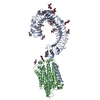
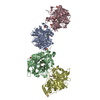
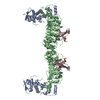

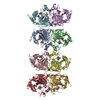
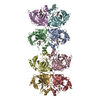

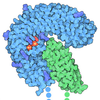







 Z (Sec.)
Z (Sec.) Y (Row.)
Y (Row.) X (Col.)
X (Col.)






















